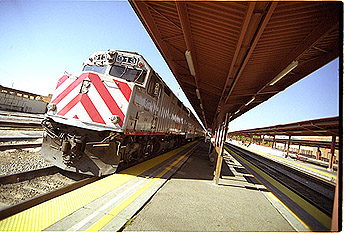![[Metroactive Features]](/features/gifs/feat468.gif)
[ Features Index | San Jose | Metroactive Central | Archives ]
Making Tracks: The peninsula's 137-year-old rail line is now more relevant than ever.
Baby Bullet
Caltrain is moving ahead with its own plan to speed up commute service
By Jeff Kearns
WITH TRUE high-speed rail at least a decade away, a different kind of fast train will be moving commuters up and down the peninsula much sooner: Caltrain's Baby Bullet. Right now, the double-tracked route from San Jose to San Francisco doesn't allow the trains headed in same direction to pass one another. The trip from San Jose to San Francisco takes more than an hour and a half--the same travel time as 50 years ago. Part of the problem is that it's still using 50-year-old technology, but more to blame is the track itself.
That's set to change with Baby Bullet, which will give commuters something they've needed for years: passing tracks.
The Baby Bullet plan would quadruple-track the line at three key points, allowing express trains to leapfrog local trains.
Caltrain spokeswoman Rita Haskin says it would cut travel time in half for the 49-mile trip from San Jose to San Francisco, to about 45 minutes. There would be just five or six stops along the way, instead of 25, and a new computerized switching system would allow speeds of 90 mph.
Track work begins early next year, and passenger service should begin in 2003. Baby Bullet would add 30 trains a day, bringing the total to 110. The project budget includes $35 million for new low-floor cars, which Caltrain is buying at a discount from a startup commuter service in Seattle that was forced to sell some of its rolling stock because of funding problems.
Haskin says Caltrain expects a surge in ridership when the new BART extension opens next fall, connecting the two transit lines at Millbrae.
A bill by state Sen. Jackie Speier (D-San Mateo) secured a $127 million state grant for Baby Bullet during the 2000 legislative session, before the energy crisis depleted the surplus. A follow-up bill introduced this year would have brought an additional $225 million to congestion relief efforts on the peninsula, but the changed financial climate killed hopes for its passage.
San Mateo County Supervisor Mike Nevin, who sits on the Caltrain board, says the upgrade is key to selling the service.
"It's speed and frequency of service that's going to get people out of their cars and off the freeway. We've gone from 68 to 80 trains since we purchased the system [in 1992] and we'd like to double the number of trains."
Caltrain officials are also studying a $500 million plan to electrify the entire line by 2006, which will increase speed, reduce noise and eliminate diesel emissions. It would be the biggest upgrade since the switch from steam to diesel in the 1950s, but cost estimates continue to rise.
"We're doing the preliminary engineering and environmental analysis right now, and it won't be out until next year," Haskin says.
[ San Jose | Metroactive Central | Archives ]
![]()
 Photograph by Jeff Kearns
Photograph by Jeff Kearns
From the October 11-17, 2001 issue of Metro, Silicon Valley's Weekly Newspaper.